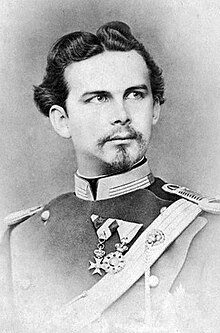| Ludwig II | |||||
|---|---|---|---|---|---|
 Ludwig, c. 1874 | |||||
| King of Bavaria | |||||
| Reign | 10 March 1864 – 13 June 1886 | ||||
| Predecessor | Maximilian II | ||||
| Successor | Otto | ||||
| Prime Ministers | |||||
| Born | 25 August 1845 Nymphenburg Palace, Munich, Bavaria, German Confederation | ||||
| Died | 13 June 1886 (aged 40) Lake Starnberg, Bavaria, German Empire | ||||
| Burial | St. Michael's Church, Munich | ||||
| |||||
| House | Wittelsbach | ||||
| Father | Maximilian II of Bavaria | ||||
| Mother | Marie of Prussia | ||||
| Religion | Roman Catholic | ||||
| Signature | |||||
Ludwig II (Ludwig Otto Friedrich Wilhelm; 25 August 1845 – 13 June 1886),[1] also called the Swan King or the Fairy Tale King (der Märchenkönig), was King of Bavaria from 1864 until his death in 1886. He also held the titles of Count Palatine of the Rhine, Duke of Bavaria, Duke of Franconia, and Duke in Swabia.[2] Outside Germany, he is at times called "the Mad King" or Mad King Ludwig.[3]
Ludwig ascended to the throne in 1864 at the age of 18 but increasingly withdrew from day-to-day affairs of state in favour of extravagant artistic and architectural projects. He commissioned the construction of lavish palaces: Neuschwanstein Castle, Linderhof Palace, and Herrenchiemsee. He was also a devoted patron of the composer Richard Wagner. Ludwig spent all his own private royal revenues (although not state funds as is commonly thought) on these projects, borrowed extensively, and defied all attempts by his ministers to restrain him. This extravagance was used against him to declare him insane, an accusation that has since come under scrutiny.[3]
Ludwig was taken into custody and effectively deposed on 12 June 1886, and he and his doctor were found dead on the following day. His death was ruled to be a suicide, a decision that has since been disputed.[4] Today, his architectural and artistic legacy includes many of Bavaria's most important tourist attractions.
- ^ At 00.28 hours: J.G. Wolf 1922, p. 16. Compare Ludwig's remark to Anton Niggl on 11/12 June 1886 about being born and going to die at 12.30 (Hacker 1966, p. 363 quoting Gerold 1914, pp. 91–93)
- ^ Adreßbuch für München (in German). Bayerische Staatsbibliothek: Ackermann. 1876.
- ^ a b Thadeusz, Frank (31 January 2014). "Mad King Ludwig? Study claims Bavarian monarch was sane". Der Spiegel. Hamburg. Retrieved 1 February 2014.
- ^ Cite error: The named reference
spiegel-07was invoked but never defined (see the help page).